Yakuza - the organized crime syndicates in Japan
Yakuza is the organized crime syndicates in Japan, like the triads in other Asian countries or Western mafia. However, the social organization and characteristics of the Yakuza is very different from other criminal groups, they even have their own office building, and their actions often and write openly in the press
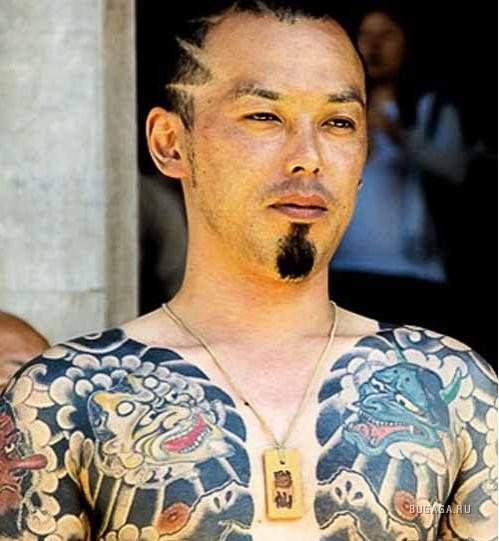
The Yakuza is a traditional form of organized crime in Japan, groups which occupy a leading position in the criminal world of the country. Members of the Yakuza also known as "gokudo". In the literature and press of the Yakuza or some group is often called the "Japanese mafia" or "borekudan". The Yakuza is based on the values of the Patriarchal family, the principles of unquestioning obedience to the boss and strict adherence to set of rules (code of the mafia), violation of which entails the inevitable punishment. The stability and durability of the Yakuza clans is a specific connection between a boss and his subordinates and the preservation of horizontal ("communal") relationships between members of the group.
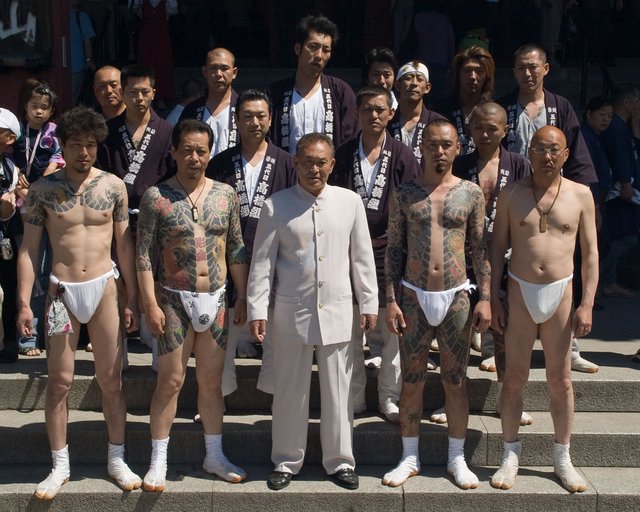
The Yakuza are closely interwoven with the economic and political life of Japan and has a number of distinctive, unique, features. Unlike other criminal entities in the world, the Yakuza does not have clearly defined territorial zones of influence, it is not based on kinship as the basis of its structural organization and does not seek to keep secret their own internal hierarchy, the number or the composition of the leadership (most of the groups, the Yakuza have their own official emblems do not conceal the location of the headquarters and the names of the bosses, in addition, many of the groups was under the "roof" of the various Patriotic or right-wing associations and unions).
Since 1950-s of the Japanese law enforcement agencies are given the number of groups and official members of the Yakuza. If a typical pre-war gang consisted of the leader and up to 50 members, then the post-war groups were joined in their ranks hundreds, and often thousands of gangsters. In 1958, the police estimated the number of the Yakuza in the 70 thousand people in 1963 to 184 thousand people, United in 5.2 thousand gangs in 1982 — in to 103.3 thousand people (more than 2.4 thousand gangs), in 1988 — at 86.3 thousand (3.2 thousand gangs).
The term "Yakuza" comes from groups of card players bakuto, named for one of the combinations of the game oyte Cabo. "Y" in Japanese means "eight", "KU", "nine", "ZA" — a modified "San", meaning "three"; in the amount of twenty, or the bad number in this Japanese card game
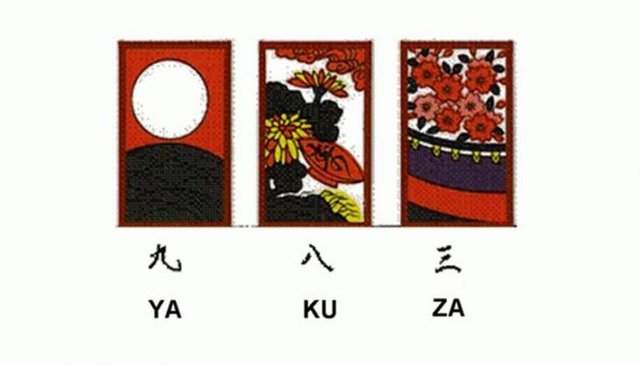
Sakya ( 総会屋 )
In the 1970s, work began on the implementation borekudan in the scope of socia (jap. 総会屋 with:Kaya) — professional corporate racketeers who blackmail business or are hired to exert pressure on recalcitrant or the company's shareholders, competitors and other business entities. Especially, this trend intensified at the turn of the 1980-ies, when there was an increase in the number borekudan among socia and the establishment of their relations with independent sokaiya who had not previously had contact with organized crime.
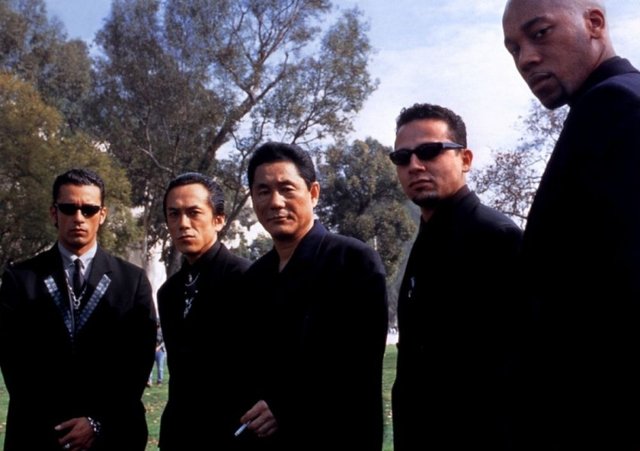
In 1982 the country was 6.3 thousand socia United 500 groups (a quarter of them worked for syndicates, the Yamaguchi-Gumi and Sumiyoshi-Kai, the rest were under the supervision of Yoshio Kodama). Annually, socia extorted from corporations by about 65 billion yen (according to other sources the figure was much longer).
After the adoption in the fall of 1982 the law changed the procedure for conducting meetings of shareholders and prohibiting cooperation with socia, some of them had engaged in fraud in the sphere of advertising, printing, trade and service.
According to police in 1987, there were about 1.3 thousand socia, 300 of whom were United in groups, and about 1.5 thousand sambugaro and Kasahara Scam infiltrated the publishing houses and companies and act like socia. Gradually, the proportion of members borekudan and their influence among socia and other scams has been steadily increasing. In the end, socia lost the initiative of holding of its shares, the Yakuza (in fact, poured into the criminal syndicates as a structural unit), and gangsters made in the work of socia own tactics
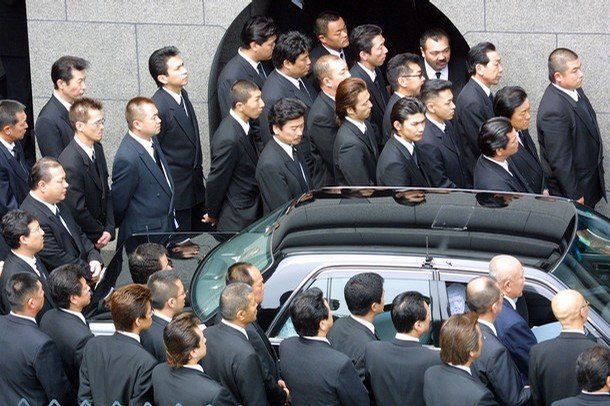
Really unusual in this Scam is that everything is done with utmost courtesy. And threats, and payments are made in a roundabout way: for example, the Yakuza organize an event like Golf tournaments or beauty contest and at inflated prices to sell to the victims of his blackmail tickets.
A similar fate was avoided and some major Japanese companies. One racketeer received eight months in prison after he tried to blackmail the leaders of the company "Mitsubishi", accusing them of the illegal deduction of lease payments for a holiday house.
By 1982, the ninth year of sokaiya has reached such proportions that it was necessary to introduce a number of laws prohibiting corporations to pay the Blackmailers. Use it brought a little, and the Yakuza had to come up with a more complex scheme to disguise their actions.
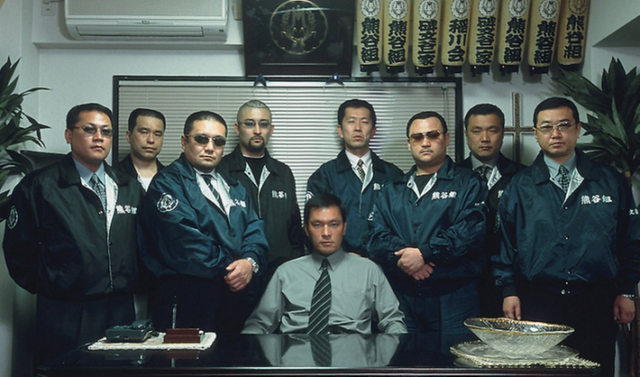
The basic method of operation, SOKIA to collect dirt on Directors and top managers of companies (including through controlled private investigators) to gather information about errors and mismanagement, in the exercise of investment or other transactions (through its agents in companies or bribing existing employees), the introduction of minority shareholders through buying small packages of shares (as own or on someone else's name), the imposition of various businessmen paid services the pressure on boards of Directors for the purpose of receiving compensation (otherwise, socia disrupted the General meeting of shareholders or tighten them, creating scandals, demanding to show certain documents, falling asleep protruding mass of written and oral questions), litigation against the companies.
Under threat of divulging compromising information, blackmail socia executives, extorting money from those loans (which are not going to give) or shares of the company. Also, Sakya and mafia-controlled companies for a fee provide entrepreneurs with illegal services — wash concealed income or hide debts written off and other flaws of the financial statements will settle the Affairs of bankrupt, putting pressure on the trade unions, minority shareholders or activists, demanding compensation for environmental damage
Yubitsume
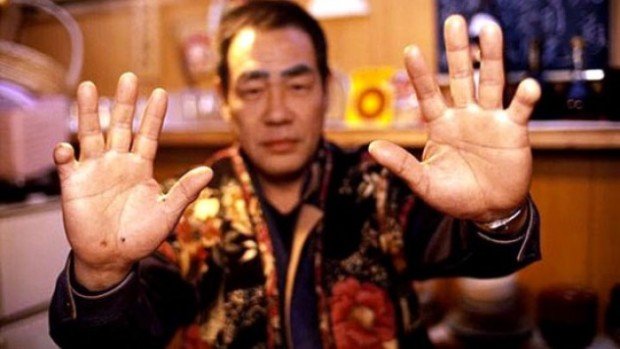
Stumbled or "lost face" the Yakuza and decided to leave the group of gangsters with the help of a tanto and the hammer silently perform the ritual amputation of phalanx of finger — yubitsume (wrapped in cloth stump, most phalanx of left little finger, presented to the boss as a symbol of the atonement of transgression).
The following error leads to amputation of the second phalanx, and then the Yakuza is transferred to another finger (in the old days all of these actions led to the fact that the gangster harder was able to wield the sword and thus increased his dependence on the will of the boss as a defender, today ritual mutilation is purely symbolic). Not to give their affiliation to the criminal world a Yakuza hide the missing fingers with prostheses. Previously, in exceptional cases, guilty or disgraced gangsters commit seppuku, but now the ritual is gone
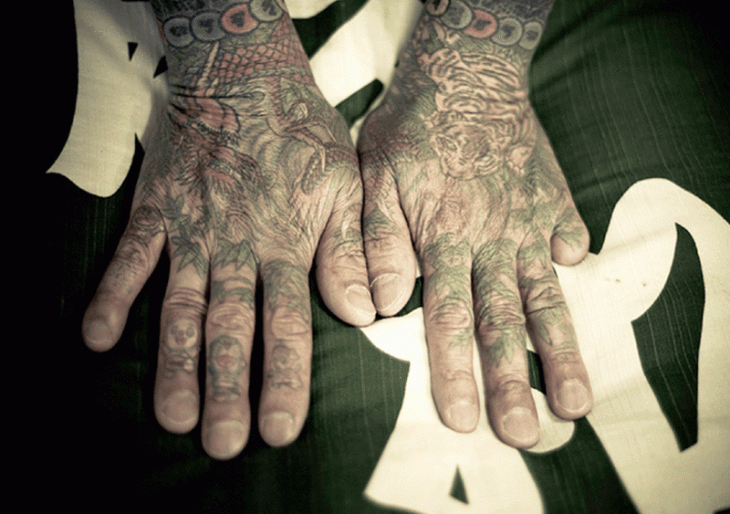
Tattoo
One of the iconic images of the Yakuza are their intricate colored tattoos all over her body. The Yakuza use the traditional method of manual entry of ink under the skin, known as irezumi — the tattoo serves as a proof of courage because this method is very painful. In recent years, the increased popularity of this style among the Yakuza. Most popular drawings usually consist of dragons, mountains and women.
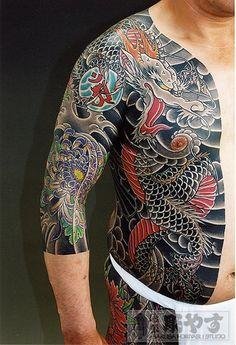
Despite the trend of tattoos spread among non-Yakuza, these signs are in Japanese society still indicate it on the members of the syndicate. The mayor of Osaka introduced a ban on such tattoos for government employees, asking them to either reduce a tattoo, or to look for work elsewhere.
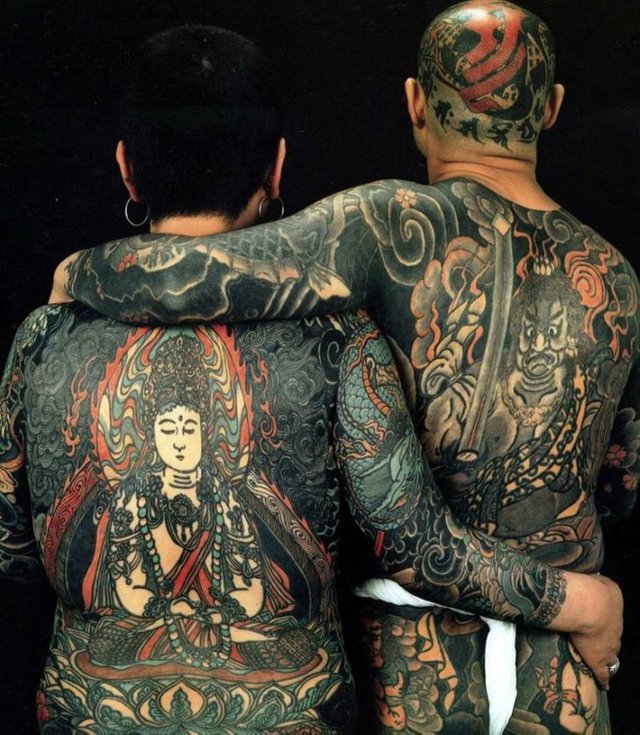
Tattoo Japanese mafia Yakuza is a whole world of characters that you can relate to these subcultures of Japan. Tattoo Yakuza men talked about their courage and kept in awe all who saw them as ordinary people not belonging to the mafia were not allowed to wear them on your body, because it was considered unworthy.
Tattoo Yakuza, sketches which reflect the culture of the country, to reproduce the elements of a style of Japanese painting called "Ukiyo-e Edo period. As images are commonly used:
- Image of mythological heroes
- Demons
- Carp and other fish
- People in traditional masks
- Animals
- The motives of the religion of Japan, Shintoism
- Elements of Buddhism
- Flowers
- Waves to fill the space between the characters as a tribute to the fact that Japan is a Maritime country.
"Kintaro" (in Japanese 金太郎) – image mythological character, "cioacha" who fights with a huge carp. Variations are different, but the meaning is always the same: it is a symbol of masculinity and bravery, of fearlessness. Typically, such an image applied to those who were especially good in the art of unarmed combat.
"Kumonryu Shishin" (in Japanese九紋龍史進) – Japanese and Chinese character, tattooed and Chinese clothing with Greek ornament. According to legend, this character was born from tattooed images of nine dragons. In his world he means innate combat abilities.
"TEU Jun" (Japanese: 張順) – image men gripped in the teeth with a knife, similar to the previous character. Often depicted with a dog is a mythical hero, Aquaman and outstanding swimmer, who according to legend was a diver for pearls. Nakalyaetsya those who are strong in spirit and proficient in melee weapons.
"Akugata" (Japanese:悪源太), also known under the names of hero Ishihira, Heian or Minamoto. According to legend, is the son of the Emperor and the simple woman who had a special skill in battle and is depicted in the most cruel and ferocious people of the Yakuza.
"Padome" (Japanese: 不動明王) is a Buddhist mythological creature that guarded the treasure. Often depicted with a sword in one hand and a rope in the other, with a creepy grin. Said this guard the sword cuts enemies – symbol error, but the network catches the infidels, arouse their righteous thoughts. Applied to those judha that have been associated with smuggling and drugs.
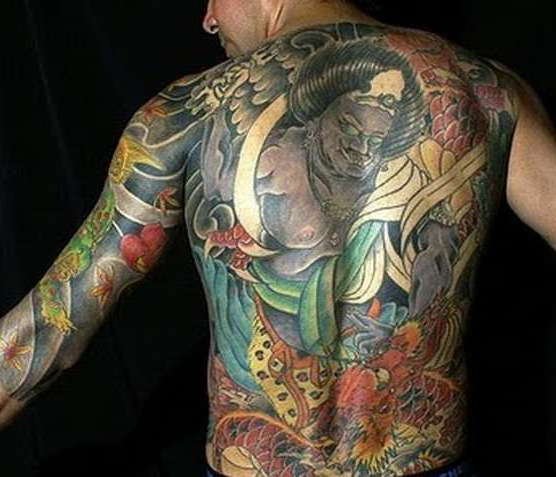
The Yakuza on the back with koi carp in Japanese style
Of course, the tattoo of the Yakuza, the value of which was so important in former times, have long lost. However, there are many followers to this day, not only among the Japanese, who revere the symbols and reproduce the work on his body. Tattoo Yakuza, a photo which you can find on the Internet, still select followers carefully and in accordance with the same symbols, which historically gave certain characters the mafia special qualities. So, a person who lacks ferocity, selects one of the symbols, while another, who lacks skill, and chooses another. The Japanese are considered to be people who are faithful to their traditions, and that is why so important for them to abide by them.
The initiation ritual
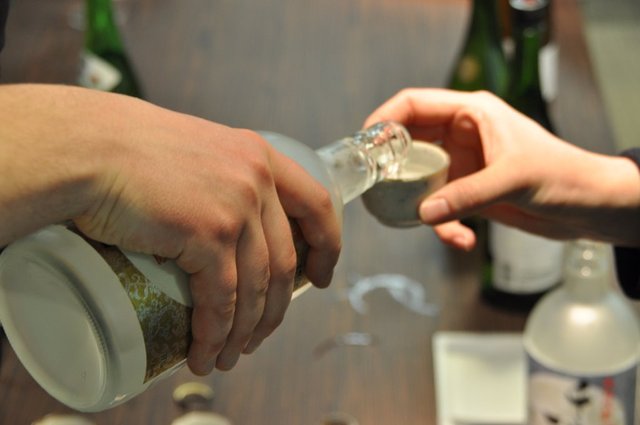
An important attribute belonging to the Yakuza tattoos are abundantly caused by gangsters on their body. This painful process can take hundreds of hours, but it is meant to symbolize the strength of character of the Yakuza.
The boss and newcomer sit opposite each other and exchanged cups of sake, thus becoming "called the father" and "called the son" (sake mixed with salt and fish scales, oabona Cup filled to the brim, Cup of a very much smaller; first they drink the little throats of their cups, then shake and drink the Cup of each other).
After the initiation ceremony, the novice becomes a full-fledged Yakuza and a member of the clan, and his family departs on the second plan, conceding superiority to the clan. If equal status "brethren" conclude a contract, the amount of sake in their cups equally
The scope of activities of the Yakuza
Traditional areas of interest are the Yakuza prostitution (including control over all brothels, massage parlours, strip clubs and saunas, as well as the importation of women for the sex industry), an underground gambling business, including betting on games in baseball and sumo, horse racing, auto and motorcycle races), drug trade (import and sale of heroin, cocaine, amphetamines and marijuana), trafficking in arms and ammunition, extortion, loan sharking, and debt collection, production or marketing of counterfeit products (expensive watches, perfumes, medicines, brand clothes, CDs, films and computer games), car theft, smuggling.
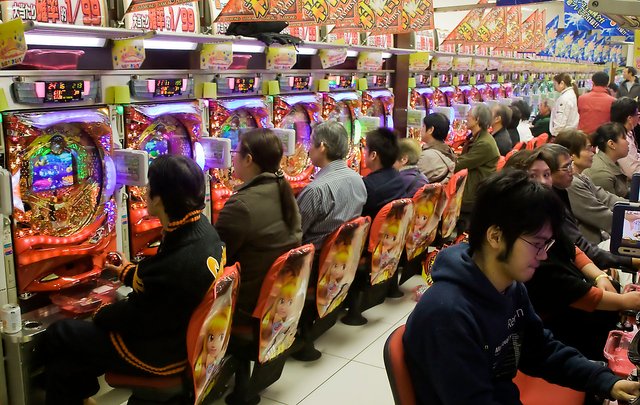
Halls pachinko — one of the estates of the Yakuza
The strong position of the group of Yakuza is in the area of real estate transactions, construction and security business, entertainment, sports, and sex tourism, production artists, and porn (including in the field of child pornography and import of pornography from Europe and America), they control numerous pachinko halls, night clubs and restaurants, as well as the organization of various festivals.
More sophisticated gangsters trades in financial fraud (especially in the market of consumer loans, automobile and medical insurance, stock trading companies and stock fraud, audit services and corporate blackmail (in this spetsializiruyutsya, socia), the laundering of "dirty money". In 1980-ies the drug trade brought the Japanese organized crime 44 % of total revenue, gambling is about 17 %
Subculture and features the Yakuza
The Patriarchal institution of the family / clan that has been preserved from feudal times, with slight modifications, continues to exert a powerful influence on the Japanese society in our days, however, most "pure" form of traditional values of this institution are preserved only in the associations of the Yakuza.
One of the main components of the subculture of the Yakuza remains a perception of a criminal gang as a "real" family, obedience to the established "paternal" and "fraternal" relations. An unwritten code of conduct for members borekudan also an essential part of the subculture, largely imitates the samurai code of Bushido.
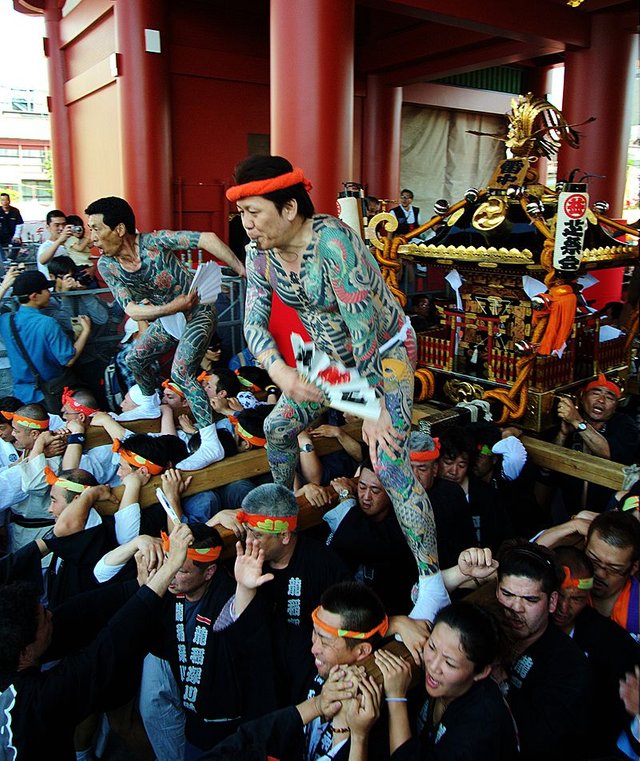
The Yakuza during a religious festival, the Sanja Matsuri
The Yakuza must endure hunger, pain (including torture) and prison sentence, is obliged to keep the secrets of the group, to remain faithful to the boss and the whole clan, unquestioningly carry out the orders of senior rank, to sacrifice for "family" (for example, to surrender to the police to confess or take the blame someone else), know criminal slang, and "tongue tattoos".
He categorically should not betray the "brothers", to assign the revenues of the group or steal from her, to encroach on the female of the other group member to do anything other than "business" of his clan, to use drugs without the order to come into collision with members of other criminal groups to commit violent and other illegal acts against foreign nationals.
In the name of maintaining the reputation of the Yakuza as fair and protect the interests of the common people of the organization, in many groups there is a rule that caused damage to the population of gang member must reimburse or even pay the penalty.
Very informative post!
Thank you!
Loved the post. It took me back to the kind of deep diving into a subject or group I would see in National Geographic Magazine. Absolutely incredible article.
I have upvoted this article and will feature it in my daily hidden gems blog post. I have also nominated you for the Robinhood Whale curators. Hopefully they will view the article in the same light as I do and push some serious voting power your way. Good luck and great job.
Thank you very much!
Great job, what an article! super interesting and with great detail.
Thank you!
This post has been linked to from another place on Steem.
Learn more about linkback bot v0.3
Upvote if you want the bot to continue posting linkbacks for your posts. Flag if otherwise. Built by @ontofractal